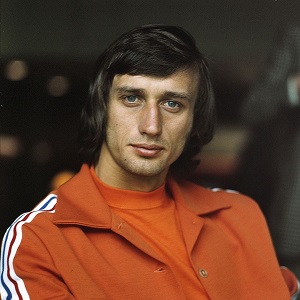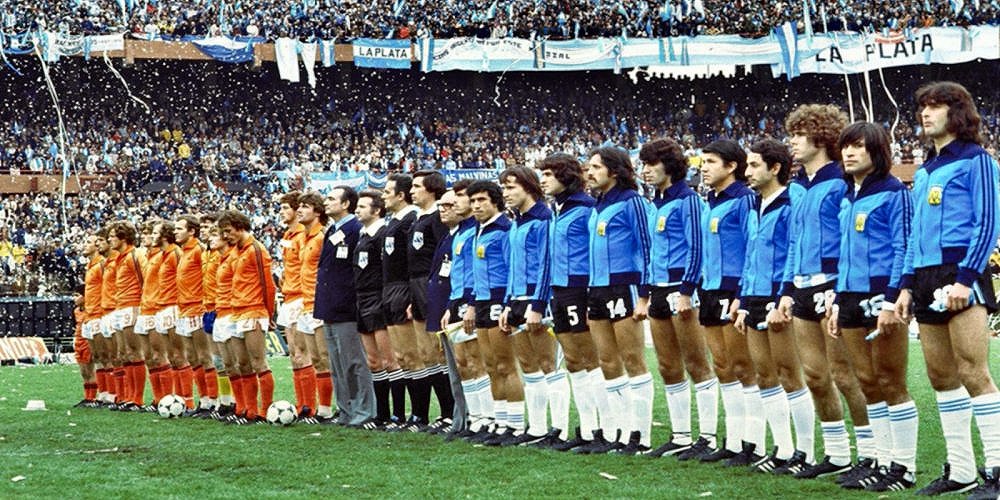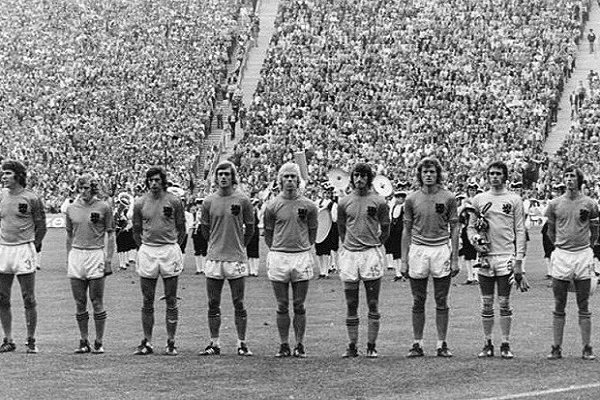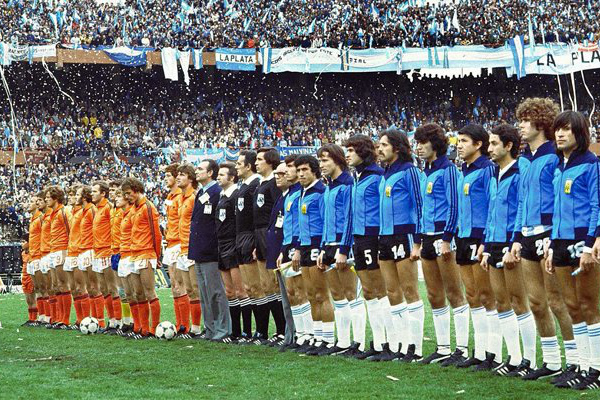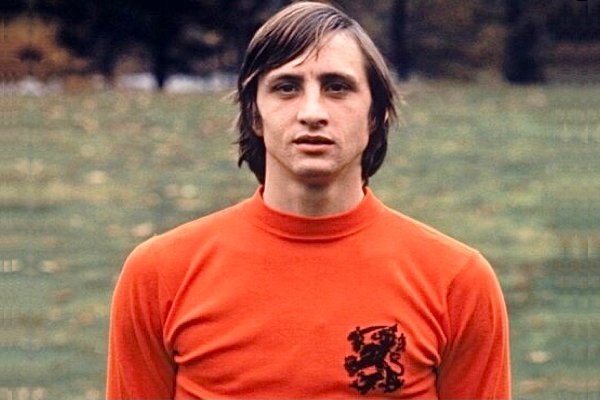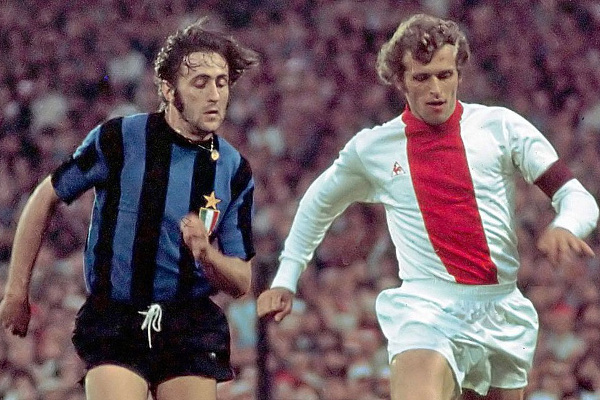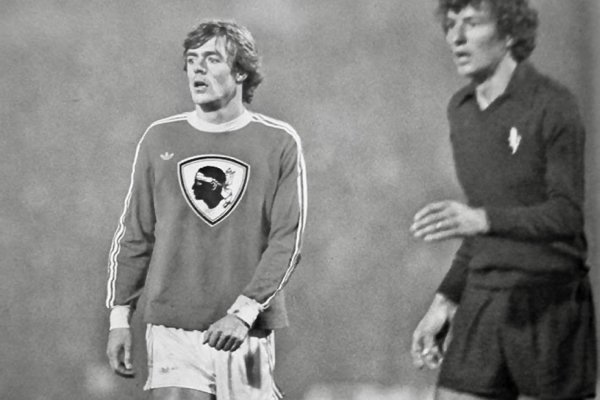Rob Rensenbrink
The Snakeman Who Nearly Became King
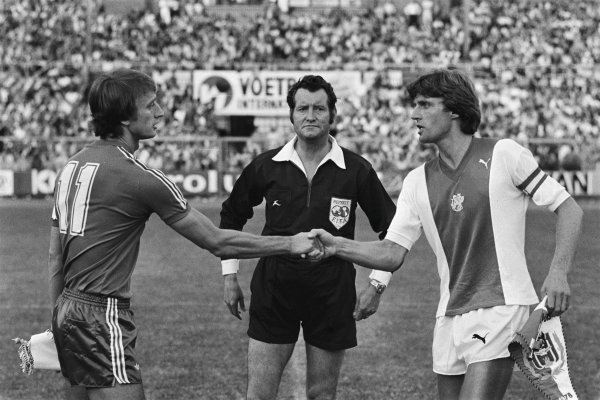
Rob Rensenbrink and Ruud Krol
Photo: Wikimedia Commons / Hans Peters
If you ask someone to name the king of Dutch football, the answer from most people will invariably be Johan Cruyff. And why not - he's a true icon of the game, a genuine legend. But what if, in the Cruyff-less World Cup Final of 1978, a tight-angled shot 14 seconds into injury-time had been an inch to the right? Then we all might be naming another holder of that crown... Rob Rensenbrink.
If Rensenbrink's opportunistic poke had gone in, not only would the Netherlands have been crowned world champions, but Rensenbrink would also have finished as the World Cup Golden Boot winner and would have been seen as the standout player of the tournament. Instead, Argentinian forward Mario Kempes pipped him to both, with his extra-time winner.
Yet whilst that goalpost may have cost Rob Rensenbrink the chance of becoming a true footballing legend, his story and career is still a great one...
Rob Rensenbrink - Career
THE EARLY DAYS AT DWS
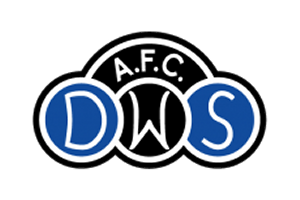
Born in Amsterdam, Rob Rensenbrink was one of the few really talented local youngsters to slip through the Ajax net in the early 1960s, so instead of starting out at Ajax's Sportpark Voorland along with other Amsterdam lads such as Johan Cruyff and Ruud Krol, he began his footballing career with another club in the city - DWS.
Despite Ajax's forthcoming dominance of the Eredivisie league in the late 1960s, DWS had incredibly become Dutch football league winners when they won the title in 1963-64, and then come close again when they finished second and fourth in the following seasons, so they had some talent in their ranks, and Rensenbrink soon started to showcase his skills there. He had a slinky, lithe style to his game, a great touch, especially with that sweet left foot of his, and an ability to beat defenders on the left wing with both traditional dribbling and bursts of speed, as well as more unconventional feints and tricks. It was this style and skill (along with his lean frame) which would eventually lead to Rensenbrink getting one of our favourite footballers' nicknames - "Het Slangenmens", meaning the Snakeman or the Contortionist.
All these attributes made the national team manager, Georg Kessler, sit up and take notice, eventually earning him a call up to the national team in 1968, for a match against Scotland.
Rob Rensenbrink had four years in the DWS first team, from 1965 to 1969. Strangely, given his success during this period, and the traditional pulling-power of the Eredivisie giants, Ajax and Feyenoord, this would be Rensenbrink's only spell in the Dutch league.
THE LEFT-WINGERS LEFT-FIELD MOVE
With Rensenbrink in such fine form in the Eredivisie, it was no surprise that all of the big Dutch clubs were interested in signing him, and it was assumed he'd make his choice between them, with the Amsterdam football powerhouse Ajax the obvious favourites.
But this is one of the things we really love about some of the players and transfer dealings from this era - the unexpected sometimes happened. Strange, unconventional moves and deals occurred every now and again that you just don't get in modern football. And so it was with Rob Rensenbrink.
So, rather than doing as expected and signing with Ajax or Feyenoord, Rensenbrink surprised everyone in 1969 with a left-field move, over the border to Belgium, and Club Brugge. The Blauw-Zwart hadn't won the Belgian First Division title since 1920, but Rensenbrink was impressed with their ambition and desire to break the ten year monopoly of Anderlecht and Standard Ličge. The move proved to be a success on a personal level, with Rensenbrink averaging a goal every two games, whilst for Club Brugge as a club it was close to being inspired as they finished runners-up during both of Rensenbrink's first two seasons in his new league.
A SECOND BELGIAN SURPRISE
Rensenbrink's form for Club Brugge on the left wing had alerted bigger clubs all around Europe, as well as the two Dutch giants who were now actually starting to dominate European club football - Feyenoord winning the European Cup in 1970 and then Ajax following suit in 1971. But again Rensenbrink sprang a massive surprise, opting to stay in Belgium and moving to Anderlecht in 1971.
So, whilst back home in the Netherlands Ajax had their own attacking legends in Johan Cruyff and Piet Keizer, and Feyenoord had theirs in Wim van Hanegem and Coen Moulijn, Rob Rensenbrink became a legend in Brussels, forging fantastic attacking partnerships with the likes of Belgian midfielders Ludo Coeck and Paul Van Himst, and Hungarian striker Attila Ladynski. Rensenbrink's goals, assists, and general performances helped bring the title back to the Parc Astrid in his first season at the club, scoring 16 goals as they pipped his former club Club Brugge to the championship on goal difference.
Another 16 goal haul in his second season at Anderlecht wasn't enough to lead them to the title though, as they finished a lowly fifth. However, the next three seasons would see Rensenbrink's best scoring stats of his career, hitting the net 20, 19 and 23 times in the league, winning a second Belgium Football League winners medal in 1974 as Anderlecht looked to reassert themselves back to the top of the domestic scene.
ESTABLISHING HIMSELF IN THE NATIONAL TEAM
Despite his fantastic form at domestic level, Rensenbrink was struggling to get a prolonged run in the national team, mainly because of Piet Keizer, Ajax's brilliant left winger. Indeed, Rensenbrink played only three times for the Oranje between 1970 and 1973, so things weren't looking great for him as his first tournament approached - the 1974 World Cup.
However, controversial events at Ajax were about to work in Rensenbrink's favour. Arguments between Cruyff and Keizer over the club captaincy were one of the reasons for Cruyff transferring to Barcelona in 1973, and the bad blood had started to spill over into the national arena, with Cruyff and Keizer hardly even on speaking terms when the squad met up for international matches. František Fadrhonc had been the national coach for the Netherlands 1974 World Cup qualifying campaign but Barcelona boss Rinus Michels was brought in by the KNVB to take the reigns for the actual tournament. Michels knew Johan Cruyff better than anyone, and realised that because of the fallout over the Ajax arguments, playing his star man up front with Keizer wasn't ideal. So, Michels changed the system to a three-man attack, with Cruyff in a roving role behind Rensenbrink on the left, and 22 year-old Ajax starlet Johnny Rep on the right.
Whilst Johan Cruyff was undroppable, there were contrasting fortunes for Rensenbrink and Rep in the opening game against Uruguay. Rep grabbed both goals as they won 2:0, whilst Rensenbrink was dropped for the next game against Sweden in favour of Keizer. However, the Ajax man didn't impress against the Swedes and Michels handed Rensenbrink the starting slot in the final group game against Bulgaria. Needing to win to ensure they went through, Rensenbrink grabbed his opportunity with a fantastic performance as they took the Bulgarians apart with a brilliant 4:1 victory.
The Rensenbrink-Cruyff-Rep partnership had now hit top form as they entered the second stage, dismantling Argentina 4:0 in the first game, and then comfortably seeing off East Germany 2:0 in the second game, Rensenbrink scoring his maiden goal of the World Cup as he slotted home their second goal from just inside the penalty area. In the final match of the group, effectively a semi-final against Brazil, Rensenbrink set up Johan Cruyff to score the second goal as the Dutch won a ferocious battle 2:0. However, the match ended in disappointment for Rensenbrink as he had to hobble off with an injury just after he'd set up Cruyff's goal.
The victory over Brazil set up a final against the hosts, West Germany. The physios had just three days to get Rob Rensenbrink fit for the final, but having had so much success with the attacking trio, Michels knew that their best chance of lifting the trophy was to have all three playing together. Rensenbrink was declared fit, but unfortunately the gamble didn't pay off, he started the final but had to be withdrawn at half-time, the injury clearly affecting him in the first half as he was unable to have the same level of impact as in the rest of the tournament. To make things even worse, the West Germans came from behind to lift the trophy, winning 2:1.
THE CUP KINGS
Back on the domestic front, Rensenbrink was the subject of heavy interest from Ajax. Having lost out to Feyenoord in the 1974 title race, they were looking to become Eredivisie winners again and also to re-establish themselves as European Cup contenders once more. They were keen to spend the money they'd received from Barcelona for Johan Neeskens on Rob Rensenbrink, but Anderlecht baulked at the idea of a cash deal, saying the only thing they'd consider was a player-swap involving Johnny Rep. Ajax declined the offer, and so Rensenbrink stayed at Anderlecht.
Rensenbrink continued to score freely for Les Mauves, but the coming seasons would prove frustrating as they ultimately failed to win another Belgian championship after their 1974 title success. This was despite landing Rensenbrink's national team-mate Arie Haan from Ajax and the emergence of talented Belgian youngsters such as Franky Vercauteren and Francois Van der Elst.
Whilst Anderlecht struggled to overturn Rensenbrink's former team, Club Brugge, in the league, they had more joy in the Belgian Cup, winning the trophy in 1975 and 1976. Their success in the domestic cup would lead to international success and some great European nights for Rensenbrink, as Anderlecht became the powerhouse of the UEFA Cup Winners Cup competition. Between 1976 and 1978 they reached three finals in a row, their 1977 defeat to Hamburger SV sandwiched between victories over West Ham United and Austria Vienna. Rensenbrink was almost unstoppable in the UEFA Cup Winners Cup competition, his 25 goals in 36 appearances making him the record scorer, ahead of Gerd Müller and Gianluca Vialli. As the competition no longer exists, it's a record that won't be broken.
Anderlecht would continue their fine cup-winning exploits into the UEFA Super Cup, defeating Bayern Munich and Liverpool in the same years as their UEFA Cup Winners Cup successes, Rensenbrink scoring in the home legs of both finals.
THE 1978 WORLD CUP. SO CLOSE, AGAIN.
1978 saw the World Cup head off to Argentina, and gave Rob Rensenbrink a second shot at the game's biggest prize.
Rinus Michels was now gone. And so was Cruyff. There was much debate at the time as to exactly why, and the real truth would only come out years later, but it did mean that extra responsibility would rest with Rensenbrink along with the other remaining stars from the 1974 World Cup, such as Rep, Neeskens and Krol.
Rensenbrink relieved the pressure on himself immediately in the opening game against Iran, scoring a hat-trick, two of them penalties as he'd taken over the duties from Johan Neeskens. A goalless draw against Peru meant that the Netherlands needed just a draw against a struggling Scotland team in their final group game. Rensenbrink made history when he opened the scoring in the 34th minute with another penalty - it was the 1000th goal in the World Cup, another great record that can never be taken away from him. A superb Scottish comeback gave the Dutch a wobble but they went through to the second round despite a 3:2 defeat.
On to the second round, and Rob Rensenbrink scored yet another penalty, his 4th of the tournament, as they demolished Austria 5:1 in the opening game of Group A. A 2:2 draw against old rivals West Germany and then a 2:1 victory in a real battle against Italy saw Rensenbrink and his team-mates head into a second successive World Cup Final, this time facing Argentina.
Again it wasn't to be. Rensenbrink came close to scoring twice, the first one being kept out by the boot of Ubaldo Fillol when they were a goal down, and the second, agonisingly, in injury time - with the scores level at 1:1 he latched onto a hopeful long ball and poked the ball past Fillol but this time it hit the post, coming straight back into the six yard box but straight into proximity of the grateful Argentinian defence who hoofed it to safety.
It remains one of the most pivotal moments in any World Cup Final, there would have been less than a minute on the clock for Argentina to find an equaliser had it gone in, and Rensenbrink would have done something that Cruyff had failed to do. But it wasn't to be, Argentina survived it and went on to win 3:1 in extra-time with Mario Kempes getting that vital bit of luck when the ball ricocheted off himself and Jan Jongbloed before he managed to force it over the line.
In those two moments the 1978 World Cup crown swapped between two of its key players, and it's Kempes who is now remembered as the tournament's star player.
Rensenbrink Hits the Postage in Stoppage Time
Rob Rensenbrink would play for the Netherlands in some of the qualifiers for the 1980 European Championships, but wouldn't make the squad for the actual tournament. So his last appearance in that famous orange shirt would be a 2:0 defeat away to Poland, as the great team of the 1970's continued to be broken up. He finished his career with the national team with 46 caps and 14 goals. It seems incredible to think that he didn't reach 50 caps, yet neither did Rep (42 caps), Neeskens (49 caps) or even Cruyff (48 caps).
THE FINAL FLOURISH
Back at Anderlecht, Rensenbrink narrowly missed out on a long overdue league title, finishing runners-up to Beveren in 1978-79, whilst the following year they finished a lowly 5th, Rensenbrink making his least number of appearances in a season (20), and scoring only 3 goals.
So, in the summer of 1980, at the age of 33, having spent 9 years at the Parc Astrid and scoring 143 goals, he finally decided to leave the club and head off to the USA to join the likes of Cruyff and Neeskens in the NASL. It was only a fleeting stay though, playing just 18 matches for the Portland Timbers in their 1980 season before he returned to Europe in 1981, and another unexpected club - French Ligue 2 outfit Toulouse, who were desperately trying to get themselves back into the top flight for the first time since they'd be reformed in 1970. Maybe it was those familiar purple shirts that attracted him to join the likes of Abdelkrim Merry Krimau and Laszlo Balint in transferring to Les Pitchouns. He only played 12 matches for them, scoring a single goal, but they did win promotion back to the top flight.
ROB RENSENBRINK - ONE OF THE GREATS
So, whilst the reality is that Rensenbrink's last-gasp shot hit the post in the 1978 final, effectively denying him genuine legendary status and the chance to be crowned the king of Dutch football, he will always be remembered as one of the greats, not just of Dutch football, but of world football throughout the 1970s.
ROB RENSENBRINK - IN ACTION
Four minutes of Rob Rensenbrink goals and skills, for club and country...
Rob Rensenbrink - Career in Brief
CLUBS
| Years | Club | |
|---|---|---|
| 1965-69 | | DWS |
| 1969-71 | | Club Brugge |
| 1971-80 | | Anderlecht |
| 1980 | | Portland Timbers |
| 1981-82 | | Toulouse |
NATIONAL TEAM
| Team | Netherlands |
|---|---|
| Debut | 1968 |
| Last Match | 1979 |
| Caps | 46 |
| Goals | 14 |
Rob Rensenbrink - Playing Style
Rob Rensenbrink - Honours
CLUBS
Other articles featuring Rob Rensenbrink
Tweet

